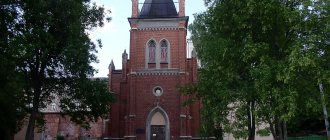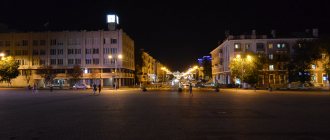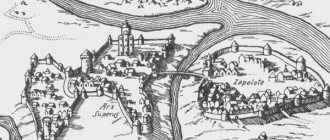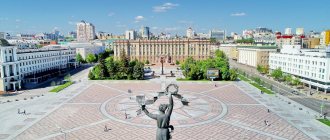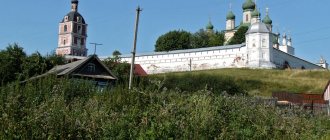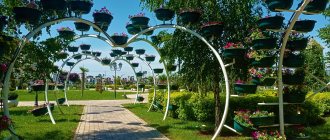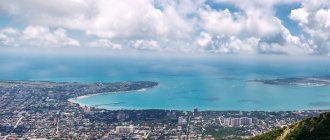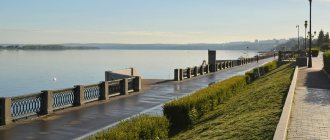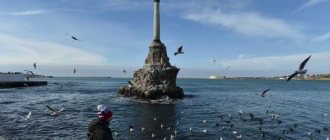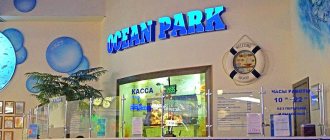The leisurely Oka flows, Kaluga has stood on it for six centuries. She did not know joyful days, The chronicle line speaks. Now the battle destroyed it, now the pestilence, now the hail.
Konstantin Altaisky
How does Kaluga appear to visitors? Most note its cleanliness and comfort. Kaluga was recently included in the Golden Ring of Russia. Kaluga traces its official history back to 1371, but it is not known for certain whether it was ever the center of the principality. The city was a merchant city, which was reflected in its architecture and attractions. Let's take a walk through the historical center of Kaluga so that you can form your own impression of it.
See tours to Kaluga HERE
Sights of Kaluga
Kaluga is one of the oldest cities in Russia, on whose territory unique cultural objects have been preserved, connecting different historical eras. The city is 650 years old – it has been mentioned in chronicles since 1371. The distance to major Russian cities such as Moscow and Tula is 160 and 100 km, respectively.
Surely many of you have heard that Kaluga is called the home of astronautics. In this article we will tell you why this is so and what space-related attractions there are in Kaluga today. Of course, astronautics objects are not the only thing that can be seen in Kaluga. This city is rich in various interesting places. And we propose to begin our acquaintance with them.
- Museum of the History of Cosmonautics, Vostok Launch Vehicle, Monument to Gagarin, Monument to the 600th Anniversary of Kaluga
- Sculpture “Scientist Cat”, Tsiolkovsky Monument on Peace Square, Tsiolkovsky House-Museum
- Teatralnaya Street, Sculpture “Bag of Good Luck”, fountain “Girl with an Umbrella”, Voskresenskaya Street
- Gostiny Dvor, City Park of Culture and Leisure, Observation Deck
- Stone Bridge, Karpov Square, Bilibin Estate, Lenin Square
- Drama Theatre, Monument to the Grateful Spectator, Kaluga Cathedral
- Museum and Local Lore Center of the Chamber of Korobovs, Border Obelisk, Golden Alley, Rakov House
- Zolotarev Palace, Makarov Chambers, Church of the Nativity of the Blessed Virgin Mary
- Museum of Fine Arts, Embankment of the Yachensky Reservoir, Museum of Local Lore
- Sculpture “Meeting of Korolev and Tsiolkovsky”, Tsiolkovsky Park, Church of Cosmas and Damian
- Public places, Statue of the Motherland, Monument to Marshal Zhukov, Shamil's house
- Monument to Kuksha, Museum-shop “Favorite Kaluga”
- Ugra National Park, Nikola-Lenivets Art Park, Sosnovy Bor
- Savior Not Made by Hands Hermitage, Kazan Ambrosievskaya Hermitage, Vvedenskaya Optina Hermitage
- Frescoes of “Borovsky Banksy”, Church of the Intercession without a single nail, Memory Square of 1812
- Ascension David's Hermitage, Chekhov Museum-Reserve in Melikhovo, Buzeon Paper Museum
- Polenov Museum-Reserve, Museum-Reserve "Polotnyany Zavod", Museum of the Three Queens
At the very end of the article you will find a map with these attractions - we have placed it so that you understand which direction you should go.
Central Park of Culture and Leisure or City Park
The park is located on the high bank of the Oka and is surrounded on three sides by government buildings. Before the revolution it was called the City Garden, and even then it was a favorite vacation spot for Kaluga residents. In the center of the park is the Trinity Cathedral, built according to the design of the architect Yasnygin on the site of a wooden one.
The cathedral is unique in that its supportless dome with a diameter of 17 meters is the largest in Russia. It contains a copy of the icon of the Kaluga Mother of God, considered miraculous.
Hotels in Kaluga: Close to center
| Hotel | Stardom | Discount | Price before discount | Select dates |
| Four Points by Sheraton Kaluga | ★★★★★ | View hotel | ||
| Hilton Garden Inn Kaluga | ★★★★ | View hotel | ||
| Best Western Kaluga | ★★★★ | View hotel | ||
| Absolute | View hotel |
In Kaluga Park, the secular coexists with the church.
Due to the fact that part of the territory is given to the Orthodox diocese, noisy entertainment events are not held here. The attractions are located in the far corner of the park, and there are few of them. At the same time, silence and tranquility give this place its charm. I really love Kaluga Park for its shady alleys, flower beds, views of the Oka River and the special atmosphere of antiquity. In the center of the park there is an ancient cast-iron fountain with an interesting history. Back in 1809, oak pipes were laid in the Old Market Square and a cast iron fountain was installed, from which local residents took water for drinking. In 1886, when the city water supply was built, the fountain was moved to the park. Shortly before the start of World War I, the fountain was decorated with a figurine of a flirtatious girl with an umbrella; according to legend, one of the merchants brought her from Italy. During the Nazi occupation, the figurine was lost, and in 1979 it was recreated from photographs. In the “dashing” 90s, the sculpture was disfigured by vyndals and again disappeared from the pedestal. And in 2010, the yoke was restored again and continues to delight Kaluga residents and guests of the city.
We can talk a lot more about the park, but our path lies further - to the Berezuevsky ravine.
What to see in Kaluga - day 1
We suggest starting your trip to Kaluga by visiting the most interesting and popular places. You can visit the Museum of the History of Cosmonautics, see the Vostok launch vehicle, the Gagarin Monument, the Monument to the 600th anniversary of Kaluga, the Scientist Cat sculpture, the Tsiolkovsky Monument on Peace Square, the Tsiolkovsky House Museum.
We also suggest taking a walk along the most beautiful streets of Kaluga - Teatralnaya and Voskresenskaya, visiting Gostiny Dvor, City Park of Culture and Leisure, Observation Deck, fountain "Girl with an Umbrella", Stone Bridge, Karpov Square, Bilibin Estate, Lenin Square, Drama Theater on the street Theater and Monument to the Grateful Spectator.
Museum of the History of Cosmonautics
Museum of the History of Cosmonautics
The Museum of the History of Cosmonautics can be called the most visited place among city guests. Kaluga is called the birthplace of astronautics for a reason: Konstantin Eduardovich Tsiolkovsky, the man who made space flights possible, lived here. Today the Museum of the History of Cosmonautics is named after Tsiolkovsky.
It is worth mentioning the fact that the Museum of the History of Cosmonautics in Kaluga is the first museum in the world with this theme. Yuri Gagarin, the first cosmonaut, and Sergei Korolev, who was involved in the creation of spaceships, also participated in the creation of this museum. We are sure that learning about the development of astronautics will be interesting for both adults and children, so feel free to buy tickets to the Museum of the History of Cosmonautics named after K.E. Tsiolkovsky in Kaluga.
In the very center of Kaluga there are the best housing options, based on price and reviews:
- Hotel "Scarlet Sails". Rating: 9.7 based on 656 reviews. Price 1250 RUB.
- Stylish Studio with Jacuzzi. Rating: 9.5 based on 70 reviews. Price 1550 RUB.
- Hotel "Priokskaya". Rating: 9.3 based on 987 reviews. Price 1650 RUB.
- Popular OKA Hotel. Rating: 9.6 based on 1,802 reviews. Price 1350 RUB.
Vostok launch vehicle
Vostok launch vehicle
The Vostok launch vehicle is located right next to the Cosmonautics Museum. This gigantic space structure is an exact copy of the Vostok rocket, on which Yuri Gagarin first flew into space on April 12, 1961. The 38-meter rocket became not only the pride of Kaluga, but of all of Russia as a whole. Although, it is worth saying that “Vostok” was not located in Kaluga right away. First, the rocket visited France, the Czech Republic, Italy, and other European countries, and years later returned to the homeland of astronautics - Kaluga.
Monument to Yuri Gagarin
Monument to Yuri Gagarin
Opposite the Museum of the History of Cosmonautics there is another attraction - a monument to Yuri Gagarin. Gagarin is depicted standing and smiling, with his arms outstretched to the sky. This image symbolizes that the astronaut is a simple and open person, ready to embrace the whole world. Leaving the main entrance of the Museum of the History of Cosmonautics, you can approach the monument and take a photo with the first cosmonaut.
Local residents will tell you about the city in as much detail as possible on these excursions:
- Informal sightseeing tour of Kaluga. Rating: 5.0 based on 85 reviews. Price 3300 RUB (for 1-5 people)
- Excursion - Fall in love with Kaluga in 1 day. Rating: 5.0 based on 35 reviews. Price 3300 RUB (for 1-10 people)
- Kaluga from merchants to astronauts. Rating: 5.0 based on 58 reviews. Price 3500 RUB (for 1-5 people)
- About Kaluga - with interest and love. Rating: 5.0 based on 45 reviews. Price 2550 RUB (for 1-4 people)
Monument to the 600th anniversary of Kaluga
Monument to the 600th anniversary of Kaluga
The monument to the 600th anniversary of Kaluga is located on Gagarin Street at the entrance to the city. The monument is a copper ball with a diameter of 11 meters and a stele with Gagarin’s facial features. The copper ball, which according to some estimates weighs 700 kg, symbolizes our planet, and the image of Gagarin is the image of the first man on Earth to conquer space. In addition, K. E. Tsiolkovsky is depicted on the marble tile lying near the monument. There are also 5 bas-reliefs nearby, reflecting the history of the city of Kaluga.
Locals call the monument the simple word “Ball”. In the summer of 2021, the “Ball” was improved: it can now be used as a screen. At night, the new function is actively used - images with sound are projected directly onto the ball. The spectacle is very beautiful, and you can see it for yourself.
Sculpture “Scientist Cat”
Monument to the “Scientist Cat”
The monument to the “Scientist Cat” is located next to the monument to the 600th anniversary of the founding of Kaluga under a spreading oak tree, just like in the fairy tale by A.S. Pushkin. The sculpture was installed in 2013, and today it is one of the most attractive monumental objects for both tourists and local residents. The scientist cat is depicted reading a book and looks very interesting. The bronze sculpture is said to weigh one ton.
Monument to Tsiolkovsky on Peace Square
Monument to K.E. Tsiolkovsky
The monument to Tsiolkovsky is located in the park on Peace Square. The sculpture of the scientist rises on a pedestal, and behind it a rocket shoots upward, symbolizing the connection between K.E. Tsiolkovsky with space. The steel rocket is 18 meters high. The monument is quite old - it is more than 60 years old, and over these 60 years it has always aroused interest among tourists.
Tsiolkovsky House-Museum
House-Museum of K.E. Tsiolkovsky
Learn about the life of the great scientist K.E. Tsiolkovsky, who made a huge contribution to the development of astronautics, can be visited in the house-museum of K.E. Tsiolkovsky. Some of his photographs, personal belongings, drawings of spaceship projects, and some astronautics studies have been preserved here. The house-museum has been operating since 1936, immediately after the death of the scientist. Many things in the house were destroyed during the Second World War; the building was also not in the best condition. But, as we see today, the house of K.E. Tsiolkovsky was able to be restored.
In the scientist’s house-museum, guides will tell you in detail about his achievements in the field of astronautics, aerodynamics, physics, rocketry, aeronautics, and even philosophy and literature. This man was so talented that you will be deeply impressed after visiting the house-museum. Therefore, we advise you to buy a ticket and visit the house-museum of K.E. Tsiolkovsky in Kaluga.
Teatralnaya Street
Teatralnaya Street
The ancient Teatralnaya Street is considered one of the most beautiful streets in Kaluga. This place is filled with an incredible atmosphere. It is created by cozy cafes and expensive restaurants, benches where you can relax, and lanterns that turn the street into a real fairy tale at night.
Teatralnaya Street is located in the center of Kaluga, between the city Park of Culture and Leisure and Teatralnaya Square. The street is constantly filled with people, because this is where there are a large number of options on how to brighten up the evening: have dinner at an aesthetic establishment, go shopping in fashion boutiques, take photos against the backdrop of beautiful architectural buildings, go to one of the performances at the Puppet Theater. We advise you to find entertainment on Teatralnaya Street. There is really a wide choice of things to do here!
Here are more inexpensive housing options in the very center of Kaluga:
- Hotel "On Dvoryanskaya". Rating: 8.5 based on 568 reviews. Price 950 RUB.
- Vintage Hotel. Rating: 8.6 based on 539 reviews. Price 1150 RUB.
- King & Queen Apartments. Rating: 8.3 based on 783 reviews. Price 1300 RUB.
- Hotel Best Western 4*. Rating: 8.8 based on 1,975 reviews. Price 1850 RUB.
Sculpture "Money Bag"
Sculpture "Money Bag"
On Teatralnaya Street there is an unusual monument - “Money Bag”. According to the author's idea, the sculpture was installed for good luck. Surprisingly, locals and tourists believe it. Residents of Kaluga and its guests are convinced that in order to find luck, you need to sit on the pedestal on which the bag is located, and for financial well-being it is enough to rub your wallet on the money bag. We advise you to check whether the local belief works.
Voskresenskaya Street
Voskresenskaya Street
Voskresenskaya Street is an ancient street of Kaluga. Its peculiarity is the preservation of architectural buildings of the 19th century in their original form, which is why the street is called the historical center of Kaluga.
Voskresenskaya Street is quiet and calm. Partly, the sparseness of this street is due to the lack of places for entertainment. But we still recommend visiting this street, because this is where you can see the amazing facades of buildings built before the 1917 revolution. It is worth noting that people still live in residential buildings from the 19th century. In general, if you want to feel the atmosphere of a bygone era, take a look at Voskresenskaya Street.
Gostiny Dvor
Gostiny Dvor
The favorite place for tourists in Kaluga, besides the Cosmonautics Museum, is Gostiny Dvor. Gostiny Dvor is a whole block of 14 buildings built from the end of the 18th century to the 20s of the 19th century. The red and white classicist buildings can be visited throughout the day. Inside Gostiny Dvor you will find souvenirs, fresh baked goods, and a fair of products from local merchants, potters and weavers. A visit to Gostiny Dvor is included in all excursions related to Kaluga, but you can also visit it on your own.
City Park of Culture and Recreation
City Park of Culture and Recreation
An ideal place for entertainment and walks in Kaluga is the City Park of Culture and Leisure. Entertainment in the park includes various rides, popcorn and cotton candy, and delicious ice cream. And walking through the park is a pleasure; there was a specially planted linden alley here, in addition there are maples, spruces, larches and other trees. The pride of the park is also a 700-year-old oak tree.
Fountain “Girl with an Umbrella”
Fountain “Girl with an Umbrella”
On Teatralnaya Street you can see an attractive girl with an umbrella, towering over the fountain - this is a monument that has survived several reconstructions, and today is the ancient fountain of Kaluga. First, birds rose above the fountain, then - the familiar girl with an umbrella. An amazing fact, but at one moment the girl disappeared, and for a long time nothing rose above the fountain. Based on photographs and the words of local residents, the sculptors managed to restore the former “Girl with an Umbrella”. In the 2000s, this sculpture was destroyed by some hooligans and reconstruction was carried out a second time. Now we see an elegant lady above the fountain who won’t mind if you take a couple of photos with her.
Observation deck
Observation deck of Kaluga City Park
There is an observation deck in the city park of culture and recreation. The observation deck offers picturesque views of Kaluga. The city stands on the Oka River, across which there is a bridge. You can look down on these objects and get new impressions. And at sunset on the observation deck you get very beautiful photos.
A stone bridge
A stone bridge
One of the oldest buildings is considered the calling card of the city - the Kaluga Stone Bridge. It was built in the 18th century. It is clear that to date the bridge has undergone several restorations, but this has not in any way affected its beauty and distinctive features. The peculiarities are that the bridge was built according to the same principle as in Italy. We can say that the Stone Bridge is a piece of Ancient Rome in Kaluga. Be sure to buy a souvenir or postcard with an image of the Stone Bridge as a memory of Kaluga!
Karpov Square
Karpov Square
If you want to take a walk in a quiet and peaceful place, go to Karpov Square. A small public garden in Kaluga with benches, fountains and green areas is perfect for romantic walks or for walks alone with your thoughts. You can come here with children - there is a children's playground. In addition, you can see many students in Karpov Square, since one of the branches of the Kaluga Pedagogical University is located here, so here
The square is named in honor of Hero of the USSR Alexander Karpov, who courageously fought the Germans during the Second World War. His bust is located here.
Bilibina Estate
Bilibina Estate
A building in the Russian Empire style on Lenin Street in Kaluga, surrounded by a beautiful forged fence, is the estate of the merchant Bilibin. Graceful architectural elements make the building special and make passersby stop to look at the façade of the house.
The three-story building from the 19th century is open to the public. There are 13 rooms in the Bilibin house: some tell about the events of the First World War, others show how the Bilibins lived. The room-museum of Imam Shamil, who lived here for several years, is also open. The guides will conduct interesting excursions in all exhibition halls and talk in detail about how the personality of Imam Shamil is connected with Kaluga too. We recommend visiting Bilibin’s estate and enlightening yourself historically.
Lenin Square
Lenin Square
Another cozy place in Kaluga is Lenin Square. It is small, but can delight you with beautiful alleys. In the center of the square there is a fountain - the highlight of this place - it has the shape of a five-pointed star. There is entertainment for children in the park - a horse ride. By paying a little money, you can give your children a boost of energy and good mood, because riding a horse is very cool!
Drama Theater
Drama Theater
The Drama Theater in Kaluga is a massive architectural structure on Teatralnaya Square. Performances are shown here at a professional level, and there are genres of plays to suit every taste. If time allows, we recommend buying a ticket to one of the performances and making sure the actors are professional.
Monument to the Theater Spectator
Monument to the Theater Spectator
Near the entrance to the Drama Theater in Kaluga there is an unusual monument - this is a monument to the theater audience, the first monument of its kind in the world. Bronze girl with a sign “No extra ticket?” in hands attracts the attention of tourists and local residents. There is a belief that if you put a coin in a girl’s purse, happiness will come to you.
Old Torg Square
We will begin our walk through the historical part of Kaluga from Old Torg Square, which was formerly called Lenin Square. The name Old Market dates back to merchant times, when there were various shopping arcades here: grain, fish, shoe, fur, kalachny, iron, silver, hardware, mosquito, apple, meat, glass and others.
In 1778, construction of the square began according to the regular plan approved by Catherine the Great. The Gostiny Ryad ensemble was built, which is the hallmark of the city. Interestingly, its authors are unknown. The construction of Gostiny Rows took more than 40 years. The ensemble includes 14 buildings.
In 2016, restoration was completed here, the area inside Gostiny Ryad was landscaped, concerts are held there in the summer, and an ice skating rink is installed in the winter.
Opposite Gostiny Ryad is the regional administration building, popularly called the “White House”. In front of it was a monument to Lenin, but in 2022 it was moved to Stary Torg Square and in its place a monument to Ivan III was erected. The Old Torg Square (formerly the Lenin Square), located to the right of Gostiny Ryad, if you are facing the administration, was the venue for parade parades before the revolution. During the war, a German military cemetery was located there. Now this square is landscaped, planted with various types of trees and shrubs, and there is an illuminated fountain in the center.
What to see and where to go in Kaluga - day 2
On the second day in Kaluga, we recommend that you visit the Kaluga Cathedral, Museum and Local Lore Center of the Chamber of Korobovs, Border Obelisk, Golden Alley, Rakov House, Zolotarev Palace, Makarov Chambers, Church of the Nativity of the Blessed Virgin Mary, Kaluga Museum of Fine Arts, Embankment of the Yachenskoye Reservoir, Local Lore Center Museum of the Kaluga Region, Sculpture “Meeting of Korolev and Tsiolkovsky”, Tsiolkovsky Park, Church of Cosmas and Damian, Public places, Statue of the Motherland.
Holy Trinity Cathedral
Holy Trinity Cathedral
The main Orthodox church in Kaluga is the Holy Trinity Cathedral. One of the architectural features of the cathedral is the dome - it is supported without supports, although it is quite large in size. Believers come to the cathedral for valuable icons: the miraculous copy of the Kaluga, Chernigov and Iveron icons of the Mother of God.
Border Obelisk
Border Obelisk
The border obelisk in Kaluga stands on an unusual border - this is the border between the southern and northern historical Kaluga. The obelisk was erected in the 18th century in honor of the founding of the city. Of course, in the 18th century the obelisk looked different - it had to be restored several times. This monument is the remains of the famous Moscow triumphal gates. Today, a snow-white obelisk rises majestically near the Kaluga Regional Philharmonic.
Golden Alley
Golden Alley
From the border obelisk along the Berezuisky ravine of Kaluga to Bazhenov Street itself, the Golden Alley spreads. This is a natural monument consisting of linden trees planted in a row, creating amazing landscapes. This place is famous not only for its slender linden trees, but also for the fact that several Russian Cultural Heritage sites are located here. We advise you to stroll along the alley and look at the unique architectural structures and majestic monuments.
Rakov's House
Rakov's House
In the center of Kaluga there is a beautiful architectural structure - this is the Rakov House. Pyotr Stepanovich Rakov is a merchant of Kaluga at the beginning of the 20th century. Rakov's house is not his place of residence, as you might think. This is a whole mansion-shop. It became one of the largest stores in Russia at that time and has not lost its purpose today. Of course, the building has not been preserved in its original form, but it is still a beautiful architectural structure, as well as a shopping center.
Zolotarev Estate
Zolotarevs' estate
The Zolotarev estate in Kaluga today is the main building of the city's Local History Museum. In ancient times, the estate of wealthy merchants was considered the most luxurious building in the city and was even called the Zolotarev Palace. The architecture of the building tells us that this estate was built for rich people: forged lanterns at the entrance to the house, skillfully made arches and high reliefs, luxurious decoration of the rooms inside.
In the main building of the Museum of Local Lore, the Zolotarev estate, you can see exhibitions dedicated to the nature and history of the Kaluga region. And if you are tired of ordinary excursions, at the Zolotarev estate you can book a theatrical excursion - you will be guaranteed a good mood for the whole day.
Makarov Chambers
Makarov Chamber
As you can already understand, Kaluga is a very rich city in architectural buildings of the 18th-19th centuries. The Makarov Chamber is also an example of civil structures built in the 18th century. The building in the Baroque style, consisting of 4 facades of bright red color, cannot be ignored - it is located in the city center, next to the Zolotarev estate. It’s surprising that now ordinary people live in a unique architectural building – the Makarov Chamber.
Church of the Nativity of the Blessed Virgin Mary
Church of the Nativity of the Blessed Virgin Mary
A temple of amazing beauty - the Church of the Nativity of the Blessed Virgin Mary - is located in the very center of Kaluga. The second name of the Nikitskaya church. Nikitskaya Church is the oldest temple in Kaluga. Inside the temple is decorated with ancient frescoes, there is an Orthodox library, and icons hang there. The relics of the Blessed Matrona of Moscow and Saints Peter and Fevronia of Murom and several miraculous icons are considered valuable religious objects. We believe that everyone should admire a baroque temple.
Stone chambers of Korobov
Stone chambers of Korobov
The stone chambers, built at the end of the 18th century, are a beautiful architectural monument and a museum and local history complex “Stone Chambers of Korobov”. The fabulous tower in the Moscow Baroque style is open to the public. The main and most interesting exposition is “Russian Izba”; in addition to it, exhibitions are held. We recommend visiting this unique architectural monument.
Park "Mir"
Park "Mir"
The embankment of the Yachenskoye Reservoir is one of the most visited places in Kaluga, as the Mir park is located here. The park is popular in the summer because it is a private closed area with a beach and two swimming pools, walking paths, cafes and restaurants, and a children's playground.
"Mir" is a park for families: there is a lot of entertainment for children. The park is often used as a venue for large events: concerts, festivals - everything takes place here. The city has tried to do everything to ensure that the park has everything necessary for a comfortable stay, so we recommend visiting it.
Sculpture “Meeting of Korolev and Tsiolkovsky”
Sculpture “Meeting of Korolev and Tsiolkovsky”
The sculpture “Meeting of Korolev and Tsiolkovsky” is located in a very symbolic place - at the intersection of Tsiolkovsky and Korolev streets. K.E. Tsiolkovsky laid out the theory of astronautics on his fingers, S.P. Korolev - turned theory into practice. Thanks to these two people, Yuri Gagarin flew into space. In the monument, the architect wanted to reflect how Tsiolkovsky supposedly “transfers knowledge” to Korolev - very unusual!
Park named after K.E. Tsiolkovsky
Park named after K.E. Tsiolkovsky
Park named after K.E. Tsiolkovsky is considered one of the main attractions of the city. The park is distinguished by its simplicity and minimalism - several alleys, a fountain, a beautiful view of the Vostok launch vehicle. Here is the grave of the great scientist K.E. Tsiolkovsky. A monument to N.V. was also erected. Gogol. Lovers of peace and simplicity should definitely check out this park.
Church of Cosmas and Damian
Church of Cosmas and Damian
The stone church in honor of the holy martyrs and unmercenaries Cosmas and Damian of Rome is considered one of the most beautiful churches in the city of Kaluga. You need to see this temple of amazing beauty in the late Baroque style at least once in your life, because there are no other buildings of this type in Kaluga.
Offices
Offices
Public places are an ensemble of buildings located on the banks of the Oka River, built in the shape of the letter “P”. The public places stand today on the site of the Kaluga wooden Kremlin, which was destroyed in the 18th century. For a long time, the administrative bodies of the city were located there, and today this function of the government offices also operates - the Kaluga Theological Seminary, the residence of Metropolitan Clement of Kaluga and Borovsk and other administrative institutions are located here. The ensemble of buildings looks very beautiful, and we advise you to check it out.
Statue of the Motherland
Statue of the Motherland
On Victory Square in Kaluga there is another memorable object that we recommend visiting - this is the monument to the Motherland. The height of the statue is 30 meters and looks very majestic. The Motherland was erected on the square in honor of the 25th anniversary of the liberation of Kaluga from the Nazi invaders. In addition, the woman, representing the image of the Motherland, holds the Earth satellite in her hands - this symbolizes victory in the field of astronautics.
A stone bridge
We have approached the former western border of the Kaluga fortress, to the deep, steep Berezuevsky ravine. Previously, the Berezuika River flowed here, which gave the name to the ravine. The ravine has still retained its steepness and depth, which in some places reaches 30 meters. The edge of the ancient Kaluga fortress lay here. After the fortress lost its defensive significance, the ravine began to interfere with the development of the city, and according to the same regular plan, it was decided to erect a bridge across it in the form of an aqueduct.
Photo by V. Komissarov
Before the entrance to the Stone Bridge, on the left on the “Golden Alley” you can see an unusual obelisk in the form of broken stone piles. This is a monument to the victims of political repression. It was opened on November 19, 1999. The monument was consecrated by the vicar of the Kaluga diocese, Bishop Georgy. By this day, only 50 people who had been subjected to repression remained alive in Kaluga.
A little further into the alley you can see the so-called “Tree of Happiness”. It appeared in 2011. According to the organizers, you should tie a colored ribbon to it and make a wish. On the wedding day, the newlyweds hang ribbons and locks on it, symbolizing the strength of family ties. On the left side of the street you see the Taneyevsky Concert Hall. Sergei Ivanovich Taneyev is a Russian composer, pianist, teacher, scientist, musical and public figure. In 1999, the hall of the Railway Workers' Palace of Culture was converted into a concert hall, which was named after Taneyev. To mark the 65th anniversary of the concert hall, a grand opening of a bust of Taneyev took place, which was installed in the hall on the 2nd floor. At the beginning of the 20th century, Taneyev gave concerts in Kaluga. The piano he played became a decoration of the living room of the Concert Hall. Pay attention to the 18th century obelisk on the left at the entrance to the bridge. It reminds us of the western border of the Kaluga fortress, until the Stone Bridge was built, later this area from where we came was already officially included in the city. There should have been two such obelisks, but in the end only one was installed. The famous Kaluga Stone Bridge is a unique work of engineering and architectural art of the late 18th century. Like the Roman viaduct, the Stone Bridge threw its powerful arches across the Berezuevsky ravine. For more than 200 years, the bridge has served the purpose for which it was built, connecting the city center with the surrounding area. Initially, it was not designed for the traffic loads that have fallen on it today. Since the end of the construction of the Stone Bridge in 1780, it has only been extensively repaired four times. In 1910, reinforced concrete flooring was made.
In April 2009, after the road surface collapsed on the bridge and a car fell into the resulting hole, the bridge was closed for restoration. The bridge is an architectural monument of federal significance and therefore neither the city nor the region could spend a penny on it. The search for funds in the federal budget began, and after several months they were allocated and work began.
After conducting research, experts found that individual structures of the viaduct were lost by 80%. The brick from which the bridge was built lost 75% of its strength characteristics due to the lack of a protective layer of brickwork. But the foundation of the bridge suffered the most wear and tear. Its supports were covered with a cultural layer of approximately 3.5 meters, and the brick, which found itself in an aggressive soil environment, was very badly damaged. Therefore, work was carried out to strengthen the foundations. Using oblique piles, the load from the bridge supports was redistributed onto a solid limestone layer, which lies at a depth of 6 meters in the Berezuisky ravine. During the reconstruction, the external brickwork had to be completely replaced.
“In all of Russia, there is probably no second such monument as the bridge over the Berezuisky ravine... The Roman viaduct in the center of Russia is what the Kaluga bridge is... When you approach the abutments of the incredibly huge bridge, you begin to understand the dream of what kind of architecture this era lived in, and you rejoice that this dream came true so unusually in an ordinary Russian city,” Nikolaev wrote in the book “On the Kaluga Land.”
Newlyweds have had a tradition for a very long time - the groom carries the bride in his arms across the Stone Bridge.
What to see in the vicinity of Kaluga
On the third day of your stay in Kaluga, we invite you to visit the outskirts of this city. You can visit the Ugra National Park, the Nikola-Lenivets Art Park, the Savior Not Made by Hands Hermitage, the Kazan Ambrosievskaya Stavropegial Women's Hermitage, the Vvedenskaya Optina Hermitage, see the Borovsky Banksy Frescoes, the Church of the Intercession without a single nail, the Memory Square of 1812, Ascension David's Hermitage, literary and memorial museum-reserve of A.P. Chekhov in Melikhovo, Museum-reserve of V.D. Polenova, Museum-Reserve "Polotnyany Zavod", Museum of Paper "Buzeon", Kaluga St. Tikhon's Hermitage, Museum and Local Lore Complex "Museum of the Three Queens".
Ugra National Park
Ugra National Park from a bird's eye view
The Ugra National Park is a two-hour drive from Kaluga. Its length is about 200 km and passes through 6 districts of the Kaluga region. Ugra National Park is home to hills and valleys, rivers and swamps, coniferous and deciduous trees, plants and animals listed in the Red Book. However, natural landscapes are not the only thing that can surprise Ugra. There are archaeological sites, ancient temples and estates, cultural monuments dedicated to the events of the Second World War. Everyone who visits the Ugra National Park will definitely discover something new and interesting.
Art park "Nikola-Lenivets"
Some objects of the Nikola-Lenivets art park
650 hectares of unique architectural and artistic objects are collected in the village of Nikola-Lenivets in the Kaluga region and make up an entire art park. Note that the Nikola-Lenivets art park is part of the Ugra NP. The art park was created thanks to the architect Vasily Shchetinin, the artist Nikolai Polissky and their like-minded people - initially these people created objects for themselves. When quite a lot of architectural objects had accumulated on the territory of the village, the idea came to create an art festival, and later an art park appeared. By the way, the tradition of holding festivals has been preserved - every year you can visit the “Archstoyanie” and “Night of New Media” festivals.
Today, on the territory of the Nikola-Lenivets art park there are more than 100 objects of contemporary art. We invite you to visit the village of Nikola-Lenivets, look into the art park and plunge into art combined with nature!
Vvedenskaya Optina Pustyn
Vvedenskaya Optina Pustyn
Vvedenskaya Optina Pustyn is a stauropegial monastery of the Russian Orthodox Church. The monastery is located in the Kaluga region, near the city of Kozelsk. Optina Pustyn includes 7 churches, the most important of which is the Vvedensky Cathedral. Famous icons and holy relics are collected there. Vvedenskaya Optina Pustyn is the main place of pilgrimage in the Kaluga region!
Savior Not Made by Hands of the Deserts
Savior Not Made by Hands of the Deserts
80 km from Kaluga there is a small village of Klykovo. We recommend visiting it for the sake of the Monastery of the Savior Not Made by Hands of the Hermitage. The Savior Not Made by Hands Hermitage is not as popular as the Optina Hermitage, but pilgrims come here to the relics of Mother Zipporah. The woman lived here before and was very wise - she guided everyone who came to her on the right path.
Kazan Ambrosievskaya stauropegial female hermitage
Kazan Amvrosievskaya women's hermitage
Between the cities of Kozelsk and Kaluga is located one of the most beautiful monasteries in the Kaluga region - the Kazan Amvrosievskaya Women's Hermitage. There are 7 temples on its territory. In the desert area there are holy springs - this is the holy spring in honor of the icons of the Mother of God “Kazan”, “Life-Giving Spring” and the spring of St. Ambrose of Optina.
Murals of "Borovsky Banksy"
Murals of "Borovsky Banksy"
Vladimir Ovchinnikov lives in the city of Borovsk, a talented artist who turns the walls of Borovsk into real masterpieces with the help of graffiti. Local residents call Ovchinnikov’s graffiti on the walls of the city frescoes of “Borovsky Banksy” - there are about 100 of them in the city. The artist depicts on the walls mainly historical events associated with the city. Art lovers should definitely visit this city, located an hour's drive from Kaluga.
Church of the Intercession in Borovsk
Church of the Intercession of the Blessed Virgin Mary
On the outskirts of Borovsk there is a unique wooden temple - the Church of the Intercession of the Blessed Virgin Mary. It is located in the courtyard of the St. Pafnutev Borovsky Monastery. The uniqueness of the temple is that it was built from pine logs without a single nail. Logically, such structures cannot stand for more than 200 years without restoration, but this temple is more than 400 years old.
Square of Memory of 1812 in Maloyaroslavets
Square of Memory of 1812
The city of Maloyaroslavets is located in the Kaluga region, km from Kaluga. The city distinguished itself during the Patriotic War of 1812 - one of the most important battles of the war took place here, which was called the Battle of Maloyaroslavets. There are mass graves in the memorial park, and monuments have been erected on three of them.
Ascension David's Hermitage
Holy Ascension David's Hermitage
Near the city of Chekhov, an hour and a half drive from Kaluga, there is the Holy Ascension David's Hermitage - a church architectural ensemble located on the banks of the Lopasn River. The churches that make up the Ascension David Hermitage were built at different times, but today they fit together perfectly. On the territory of the desert there is a Holy Spring and a Holy Grove, which the clergy can tell you about in more detail.
Literary and Memorial Museum-Reserve of A.P. Chekhov in Melikhovo
Literary and Memorial Museum-Reserve of A.P. Chekhov
The Literary and Memorial Museum-Reserve of A.P. Chekhov is located in the village of Melikhovo, where the writer lived for several years. His house, which is now a museum, contains personal belongings and photographs. You can hear from museum guides how he lived, where he worked, where he dined, where he vacationed, and the most important thing is that you can not only hear it all, but also see it with your own eyes. Therefore, we advise you not to miss this opportunity and go to Melikhovo.
Museum-reserve V.D. Polenova
Museum-reserve V.D. Polenova
A two-hour drive from Kaluga is the village of Strakhovo, which you should definitely stop by to visit the V.D. Museum-Reserve. Polenova. Russian artist Vasily Polenov considered this area his homeland. The artist put his whole soul into the design of his house - the building turned out to be very elegant with a combination of different styles of European architecture. In addition to Palenov’s house, you can see his workshop, half-timbered buildings, a park and a garden.
Museum-reserve "Polotnyany Zavod"
Museum-reserve "Polotnyany Zavod"
The estate of the Goncharovs and Shchepochkins “Polotnyany Zavod” is located 40 km from Kaluga. This is the place where Natalya Goncharova lived and the great poet Alexander Pushkin walked. The estate was considered at one time one of the richest houses in Russia. You will be told during the tour how the estate is connected with Pushkin and Goncharova, why it is called “Polotnyany Zavod” and many other interesting facts, so we recommend that you visit the exhibitions of the “Polotnyany Zavod” museum-reserve.
Buzeon Paper Museum
One of the expositions of the museum=Buzeon estate
In the 18th century, a paper production plant operated on the territory of the Kaluga region, which, by the way, still performs its function to this day. The Buzeon Paper Museum opened in the building of this plant and tells visitors about all the intricacies of paper production. Also, museum guests have a unique opportunity to take part in the paper production process, or rather, try to make paper the way it was done in past centuries.
St. Tikhon's Hermitage
Kaluga St. Tikhon's Hermitage
The Kaluga St. Tikhon's hermitage is located in the village of Leo Tolstoy. The mixture of Russian and Byzantine style gives the ensemble of 6 temples some specialness. In addition to churches, you will find 2 museums in St. Tikhon's Hermitage. Divine services take place in the desert every day.
Museum and local history complex "Museum of the Three Queens"
Museum and local history complex "Museum of the Three Queens"
One of the oldest cities in the Kaluga region is Meshchovsk. The Museum of the Three Queens in Meshchovsk will tell you about the natives of the city who in the future began to bear the Romanov surname. In addition to exhibitions dedicated to the Romanov dynasty, you will find exhibition halls telling about the history of the city, starting from the 12th century.

